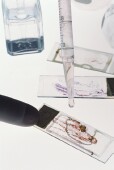
THURSDAY, Feb. 18 (HealthDay News) — Researchers have found a way to analyze the “fingerprint” of a cancer, and then use that fingerprint to track the trajectory of that particular tumor in that particular person.
“[This technique] will allow us to measure the amount of cancer in any clinical specimen as soon as the cancer is identified by biopsy,” said study co-author Dr. Luis Diaz, an assistant professor of oncology at Johns Hopkins University. “This can then be scanned for gene rearrangements, which will then be used as a template to track that particular cancer.”
Diaz is one of a group of researchers from the Ludwig Center for Cancer Genetics and Therapeutics and the Howard Hughes Medical Institute at Johns Hopkins Kimmel Cancer Center that report on the discovery in the Feb. 24 issue of Science Translational Medicine.
This latest finding brings scientists one step closer to personalized cancer treatments, experts say.
“These researchers have determined the entire genomic sequence of several breast and colon cancers with great precision,” said Katrina L. Kelner, the journal’s editor. “They have been able to identify small genomic rearrangements unique to that tumor and, by following them over time, have been able to follow the course of the disease.”
One of the biggest challenges in cancer treatment is being able to see what the cancer is doing after surgery, chemo or radiation and, in so doing, help guide treatment decisions.
“Some cancers can be monitored by CT scans or other imaging modalities, and a few have biomarkers you can follow in the blood but, to date, no universal method of accurate surveillance exists,” Diaz stated.
Almost all human cancers, however, exhibit “rearrangement” of their chromosomes.
“Rearrangements are the most dramatic form of genetic changes that can occur,” study co-author Dr. Victor Velculescu explained, likening these arrangements to the chapters of a book being out of order. This type of mistake is much easier to recognize than a mere typo on one page.
But traditional genome-sequencing technology simply could not read to this level.
Currently available next-generation sequencing methods, by contrast, allow the sequencing of hundreds of millions of very short sequences in parallel, Velculescu explained.
For this study, the researchers used a new, proprietary approach called Personalized Analysis of Rearranged Ends (PARE) to analyze four colorectal and two breast cancer tumors.
First, they analyzed the tumor specimen and identified the rearrangements, then tested two blood samples to verify that the DNA had been shed into the blood, sort of like a tumor’s trail of bread crumbs.
“Every cancer analyzed had these rearrangements and every rearrangement was unique and occurred in a different location of genome,” said Velculescu. “No two patients had the same exact rearrangements and the rearrangements occurred only in tumor samples, not in normal tissue,” he noted.
“This is a potentially highly sensitive and specific tumor marker,” Velculescu added. Levels of the biomarkers also corresponded with the waxing and waning of the tumor.
“When the tumor progresses, the relative amount of the rearrangement increases in the blood and goes down after chemotherapy,” Diaz said. “It tracks very nicely with the clinical history of the tumor.”
The method would not be used for cancer screening and more research needs to be done to make sure PARE doesn’t detect low-level tumors that don’t actually need any treatment.
Although this approach is currently expensive (about $5,000 versus $1,500 for a CT scan), the authors anticipate that the cost will come down dramatically in the near future, making PARE more cost-effective than a CT scan.
Under the terms of a licensing agreement, three of the study authors, including Velculescu, are entitled to a share of royalties on sales of products related to these findings.
More information
The American Cancer Society has more on personalized cancer care.

